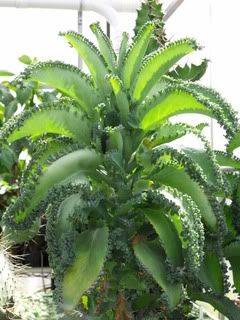Mother-of-Thousands

Kalanchoe daigremontiana goes by a couple of common names. The most familiar of those is Mother-of-Thousands, or Mother-of-Millions, but some call it the Mexican Hat Plant. There are also other plants in the same genus Kalanchoe that are also referred to as Mother of Thousands such as Kalanchoe fedtschenkoi. The name Mother-of-Thousands refers to the fact that these plants are viviparous; seedlings develop directly on the mother plant, eventually dropping off and taking root on their own. This is great if you like to share plants with friends and family or if you want to get a lot of plants for yourself from one original plant. However you look at it, this plant is pretty interesting.
 The Mother-of-Thousands plant likes sun. Indoors, the brightest window you have is best. Go for a southern exposure if you can, but western or eastern windows work as well. If you live in the south you may want to protect this plant from direct sun around midday; the sun coming through the window may be too hot and scorch the plant or simply stress it out.
The Mother-of-Thousands plant likes sun. Indoors, the brightest window you have is best. Go for a southern exposure if you can, but western or eastern windows work as well. If you live in the south you may want to protect this plant from direct sun around midday; the sun coming through the window may be too hot and scorch the plant or simply stress it out.
Plant your Mother-of-Thousands in a well-drained potting mix in a pot that has holes in the bottom for drainage. If you tend to over-water your plants, it may be a good idea to mix in some extra perlite. Water when the soil is getting pretty dry but has not quite dried out all the way for best results. Fertilize weakly during the active growing season, spring through fall.
The Mother-of-Thousands does flower, though some plants never do. The flowers are usually a bright candy-pink but are sometimes seen in more of a coral or light orange. They are not fragrant and sometimes the mother plant will die after flowering. If your plant appears to be about to flower and you are concerned about the mother plant dying, it is extremely simple to start some new plants.
To propagate from your Mother-of-Thousands (if it doesn’t do so prolifically on its own) simply place some of the baby plantlets onto a moistened potting mix and lightly cover with plastic wrap to keep the humidity up. Leave them in bright indirect light until they take root and begin to grow on their own. It is not necessary to be this careful in propagation of these plants as the mother plant is pretty good at taking care of it all by itself. These are just some tips to increase your chances of success.

Plant your Mother-of-Thousands in a well-drained potting mix in a pot that has holes in the bottom for drainage. If you tend to over-water your plants, it may be a good idea to mix in some extra perlite. Water when the soil is getting pretty dry but has not quite dried out all the way for best results. Fertilize weakly during the active growing season, spring through fall.
The Mother-of-Thousands does flower, though some plants never do. The flowers are usually a bright candy-pink but are sometimes seen in more of a coral or light orange. They are not fragrant and sometimes the mother plant will die after flowering. If your plant appears to be about to flower and you are concerned about the mother plant dying, it is extremely simple to start some new plants.
To propagate from your Mother-of-Thousands (if it doesn’t do so prolifically on its own) simply place some of the baby plantlets onto a moistened potting mix and lightly cover with plastic wrap to keep the humidity up. Leave them in bright indirect light until they take root and begin to grow on their own. It is not necessary to be this careful in propagation of these plants as the mother plant is pretty good at taking care of it all by itself. These are just some tips to increase your chances of success.
This site needs an editor - click to learn more!
You Should Also Read:
Kalanchoe
ZZ Plant
Houseplants Newsletter 
Related Articles
Editor's Picks Articles
Top Ten Articles
Previous Features
Site Map
Content copyright © 2023 by Lisa Beth Voldeck. All rights reserved.
This content was written by Lisa Beth Voldeck. If you wish to use this content in any manner, you need written permission. Contact
BellaOnline Administration
for details.


